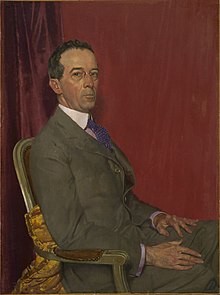Robert Sterling Clark
Robert Sterling Clark (also Sterling Clark) (born June 25, 1877 in New York City , † December 29, 1956 in Williamstown ) was an American entrepreneur, art collector, patron. After taking part in an expedition to China, he published a travel diary with scientific publications. He and his wife founded the Sterling and Francine Clark Art Institute .
youth
Sterling Clark was born in New York as one of four children to entrepreneur Alfred Corning Clark and his wife Elizabeth Scriven Clark . His grandfather Edward Clark , a lawyer, founded the Singer sewing machine company in 1851 together with the inventor Isaac Merritt Singer , of which he was president from 1875. The IM Singer & Company became the largest sewing machine manufacturers in the world, with production facilities in many countries. Sterling Clark's parents had already built up a small collection of paintings so that he grew up in an environment that was not only wealthy but also interested in art. After finishing school he started an engineering degree at the Sheffield Scientific School of Yale University , where he graduated 1899th
China
He then went to the United States Army , where he was first involved in the American occupation of the Philippines in the Philippine-American War and later in the suppression of the Boxer Rebellion in China . After the fighting ended, he returned to the United States and worked for the Army in Washington, DC for another two years. In 1903 he returned to China and began in the following years with preparations for an extensive expedition to the Chinese province of Shaanxi, which he financed . Together with the zoologist Arthur de Carle Sowerby (1885-1954) and 36 other people, he undertook the Clark expedition named after him in 1908/09 , which carried out cartographic, ethnological and zoological research in the north of this province. After the murder of their interpreter, however, this expedition was abruptly broken off. The travel diary and the scientific results were later published in book form.
Art collector
Sterling Clark settled in Paris in 1911 and began building his art collection. Together with his brother Stephen Carlton Clark , also an important collector, he traveled to Florence in 1912 and purchased the portrait of a lady from Domenico Ghirlandaio. Other paintings, mainly by Italian, Flemish and Dutch masters, followed in a short time. In 1919 he married the French woman Francine Clary (1876–1960), an actress from the Comédie-Française , who subsequently had a great influence on her husband's taste in art. Together they expanded the existing collection over the next 35 years, but shifted the main focus to French painters of the 19th century. The couple acquired more than 35 paintings by Pierre-Auguste Renoir and numerous works by the other impressionists from the dealers Knoedler and Durand-Ruel . In addition to pictures from the Barbizon School and works by American artists, a sizeable collection of Old English silverwork was created. Due to inheritance disputes, Sterling Clark fell out with his brother Stephen in 1923 and neither spoke a word to one another for their entire lives, but competed for the best pictures in the art market. While his brother played a prominent role in the American East Coast society and later donated his collections to public collections, Sterling and Francine Clark lived largely withdrawn and rarely loaned works of art for exhibitions. In addition to painting horses represented the second passion of the Clarks represents Sun won her horse. Never Say Die 1954, the Derby of Epsom and many paintings with horse motifs in their collection still bear witness to their enthusiasm for horses.
museum
The Clarks' collection soon reached a level that made it impossible to keep all of the artwork in their Manhattan townhouse . An increasing number of art treasures were being stored and the Clarks were concerned about the future of their collection. At first there were ideas to found a museum in Copperstown , the residence of his parents, or to leave the collection to the Metropolitan Museum of Art . In Copperstown, however, his brother Stephen Clark had already founded the Baseball Hall of Fame and the Fenimore Art Museum , and at the same time he was on the board of trustees of the Metropolitan Museum. In 1946, Sterling and Francine Clark decided to convert their townhouse, modeled on the Frick Collection, into a collectors' museum, before finally, fearing a nuclear attack on New York City, they decided to relocate their collection to the supposedly safer Williamstown , Massachusetts , where the Father and grandfather of Sterling Clark had studied. The Sterling and Francine Clark Art Institute opened on May 17, 1955, half a year before Sterling Clark died. In addition to the museum, he also created the Robert Sterling Clark Foundation , which not only supports art but also social projects.
Images from the Sterling and Francine Clark Collection
Publications
- Robert Sterling Clark, Arthur de Carle Sowerby: Shên-kan: The Account of the Clark Expedition in North China, 1908-1909 . London and Leipzig 1912
literature
- Michael Conforti, James A. Ganz, Neil Harris, Sarah Lees, Gilbert T. Vincent: The Clark Brothers Collect, Impressionist and Early Modern Paintings . New Haven and London ISBN 0-931102-65-0
- John H. Brooks: Highlights, Sterling and Francine Clark Art Institute. Williamstown 1981 ISBN 0-931102-16-2
Web links
- Homepage of the Sterling and Francine Clark Art Institute
- Homepage of the Robert Sterling Clark Foundation
| personal data | |
|---|---|
| SURNAME | Clark, Robert Sterling |
| ALTERNATIVE NAMES | Clark, Sterling |
| BRIEF DESCRIPTION | American entrepreneur, author, art collector, patron and museum founder |
| DATE OF BIRTH | June 25, 1877 |
| PLACE OF BIRTH | new York |
| DATE OF DEATH | December 29, 1956 |
| Place of death | Williamstown |









